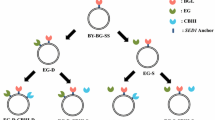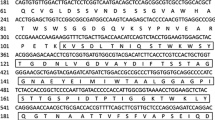Abstract
To enhance the use of cellobiose by a recombinant Sachharomyces cerevisiae, the expressed β-glucosidase that hydrolyzes cellobiose was stabilized using a surface-display system. The C-terminal half of α-agglutinin was used as surface-display motif for the expression of β-glucosidase in the cell wall. The surface-displayed β-glucosidase had a half-life time (t 1/2) of 100 h in acidic culture broth conditions, while secreted β-glucosidase had a t 1/2 of 60 h. With such stabilization of β-glucosidase, the surface-engineered S. cerevisiae utilized 7.5 g cellobiose l−1 over 60 h, while S. cerevisiae secreting β-glucosidase into culture broth used 5.8 g cellobiose l−1 over the same period.
Similar content being viewed by others
References
Adam AC, Polaina J (1991) Construction of a Saccharomyces cerevisiae strain able to ferment cellobiose. Curr. Genet. 20: 5-8.
Benhar I (2001) Biotechnological applications of phage and cell display. Biotechnol. Adv. 19: 1-33.
Bothast RJ, Nicholas NN, Dien BS (1999) Fermentations with new recombinant organisms. Biotechnol. Prog. 15: 867-875.
Chandrakant P, Bisaria VS (1998) Simultaneous bioconversion of cellulose and hemicellulose to ethanol. Crit. Rev. Biotechnol. 18: 295-331.
Cho KM, Yoo YJ, Kang HS (1999) δ-Integration of endo/exoglucanase and β-glucosidase genes into the yeast chromosomes for direct conversion of cellulose to ethanol. Enzyme Microb. Technol. 25: 23-30.
Duff SJ, Murray MD (1996) Bioconversion of forest products industry waste cellulosics to ethanol: a review. Bioresour. Technol. 55: 1-33.
Dunn IS (1996) Phage display of proteins. Curr. Opin. Biotechnol. 7: 547-553.
Georgoiu G, Stathopoulos C, Daugherty PS, Nayak AR, Iverson BL, Curtiss RI (1997) Display of heterologous proteins on the surface of microorganisms: from the screening of combinatorial libraries to live recombinant vaccines. Nat. Biotechnol. 15: 29-34.
Ingram LO, Aldirch HC, Borges AC, Causey TB, Martinez A, Malales F, Saleh A, Underwood SA, Yomano LP, York SW (1999) Enteric bacterial catalysts for fuel ethanol production. Biotechnol. Prog. 15: 855-866.
Lipke PN, Wojciechowicz D, Kurjan J (1989) Agα1 is the structural gene for the Saccharomyces cerevisiae α-agglutinin, a cell surface glycoprotein involved in cell-cell interactions during mating. Mol. Cell. Biol. 9: 3155-3165.
Lu C, Kurjan J, Lipke PN (1994) A pathway for cell wall anchorage of Saccharomyces cerevisiae α-agglutinin. Mol. Cell. Biol. 14: 4825-4833.
Lynd LR, Cushman JH, Nicolas RJ, Wyman CE (1991) Fuel ethanol from cellulosic biomass. Science 251: 1318-1320.
Mielenz JR (2001) Ethanol production from biomass: technology and commercialization status. Curr. Opin. Microbiol. 4: 324-329.
Mochizuki D, Miyahara K, Matsuzaki H, Hatano T, Fukui S, Miyakawa T (1994) Overexpression and secretion of cellulolytic enzymes by δ-sequences of Saccharomyces cerevisiae. J. Ferm. Bioeng. 77: 468-473.
Murai T, UedaM, Kawaguchi T, Arai M, Tanaka A (1998) Assimilation of cellooligosaccharides by a cell surface-engineered yeast expressing β-glucosidase and carboxymethylcellulase from Aspergillus aculeatus. Appl. Environ. Microbiol. 64: 4857-4861.
Pack SP, Cho KM, Kang H, Yoo YJ (1998) Development of cellobiose-utilizing yeast for ethanol production from cellulose hydrolyzate. J. Microbiol. Biotechnol. 8: 441-448.
Sambrook J, Russell DW (2001) Molecular Cloning, a Laboratory Manual, 3rd edn. Cold Spring Harbor, New York: Cold Spring Harbor Laboratory Press.
Schreuder MP, Mooren AT, Toschika HY, Verrips CT, Klis FM (1996) Immobilizing proteins on the surface of yeast cells. Trends Biotechnol. 14: 115-120.
Ueda M, Tanaka A (2000) Genetic immobilization of proteins on the yeast cell surface. Biotechnol. Adv.. 18: 121-140.
Van Rensburg P, Van Zyl WH, Pretorius IS (1998) Engineering yeast for efficient cellulose degradation. Yeast 14: 67-76.
Author information
Authors and Affiliations
Rights and permissions
About this article
Cite this article
Pack, S.P., Park, K. & Yoo, Y.J. Enhancement of β-glucosidase stability and cellobiose-usage using surface-engineered recombinant Saccharomyces cerevisiae in ethanol production. Biotechnology Letters 24, 1919–1925 (2002). https://doi.org/10.1023/A:1020908426815
Issue Date:
DOI: https://doi.org/10.1023/A:1020908426815




